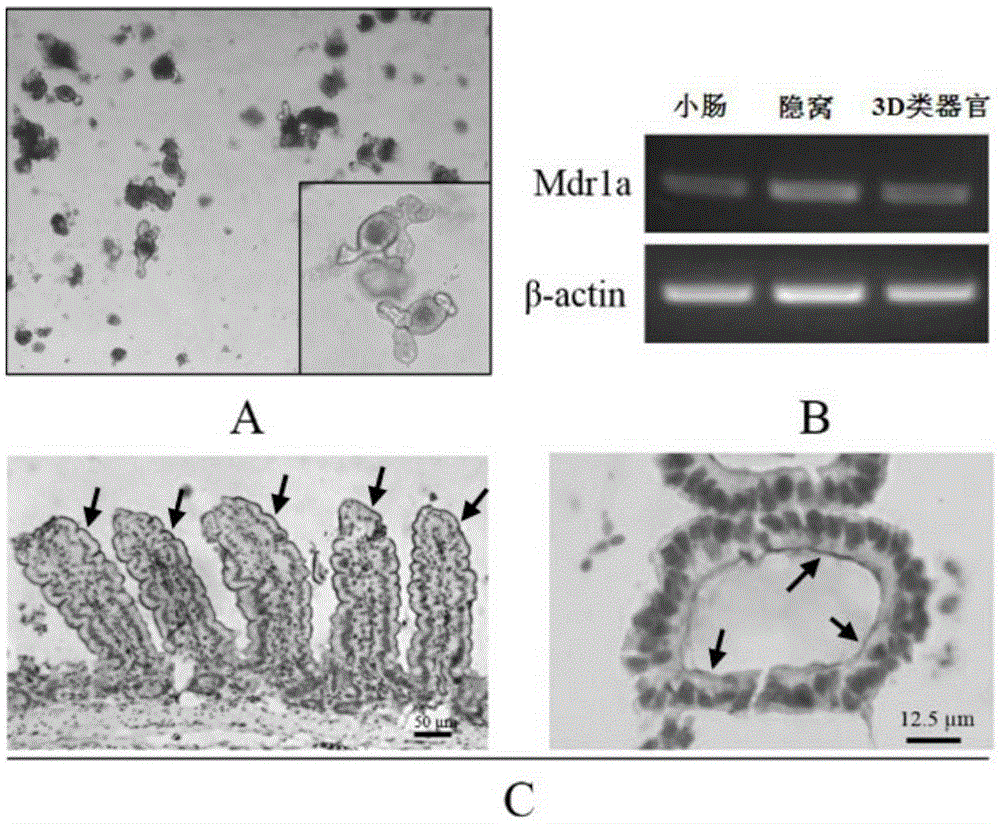Method for detection of P-gp mediated Rh123 transport in 3D type organ and application thereof
A technology of rh123 and organoids, which is applied in the field of biomedicine, can solve the problems of time-consuming and cumbersome processes, and achieve the effect of easy operation, simple operation and realization of screening
- Summary
- Abstract
- Description
- Claims
- Application Information
AI Technical Summary
Problems solved by technology
Method used
Image
Examples
Embodiment 1C57
[0042] Example 1 Sorting of C57BL / 6 Mouse Crypts and Culture of 3D Organoids
[0043] (1) Take the small intestine of 6-8 week-old C57BL / 6 mice, divide it into several 5-8cm long segments, cut it from the middle, and wash it with pre-cooled phosphate buffered saline (PBS). Remove the small intestinal villi with a coverslip and transfer it to a 50 ml centrifuge tube containing an appropriate amount of PBS and place on ice.
[0044] (Note: All the following steps should be performed in a sterile environment, and the crypts should be placed on ice as much as possible.)
[0045] (2) In a biosafety cabinet, wash 3-4 times with PBS containing penicillin / streptomycin (P / S), then transfer the small intestine fragment to 25ml PBS containing 2mM EDTA, and digest it in a refrigerator at 4°C for 10min.
[0046] (3) Transfer the digested small intestine fragments to a 50ml centrifuge tube, add 25ml PBS containing P / S, shake vigorously 50 times, and collect the suspension; transfer the sma...
Embodiment 23D
[0052] Example 2 Verification of 3D organoid model
[0053] 2.1 Observation of 3D organoid morphology
[0054] When the crypts of C57BL / 6 mice were cultured to the fourth day, they were observed and photographed under an OlympusIX71 microscope equipped with an OlympusDP71 camera system, and the results were as follows figure 2 -A shown. From figure 2 In -A, it can be seen that the organoid structure formed by the differentiation of crypts, the center is surrounded by cells to form a spherical cavity, and the peripheral "buds" are new crypts formed by the differentiation of stem cells.
[0055] 2.2 mRNA level to prove the expression of P-gp in 3D organoids
[0056] (1) Extraction of mRNA from small intestine, crypts and 3D organoids of C57BL / 6 mice
[0057] Take an appropriate amount of homogenized small intestines, crypts, and four-day-cultured 3D organoids of mice, respectively, and place them in 1.5ml EP tubes, and add an appropriate amount of Trizol to it to extract t...
Embodiment 33D
[0091] Example 3 Detection of P-gp-mediated Rh123 in 3D organoids and the effect of Verapamil on Rh123 transport
[0092] (1) Establishment of Rh123 standard curve
[0093] Prepare a Rh123 stock solution with a concentration of 1 mM, and dilute it with PBS to 500, 200, 100, 50, 20, 10, and 5 nM standard solutions in sequence, and each concentration has three parallels. Utilize the multifunctional microplate reader (FLUOStarOPTIMA) to detect, the parameter is set as the excitation wavelength 485nm, emission wavelength Fluorescence intensity of Rh123 at different concentrations was measured at 535nm. With the concentration of Rh123 as the abscissa and the fluorescence intensity as the ordinate, perform linear regression, such as image 3 shown. In the range of 5-500nM, the concentration of Rh123 is linear to the fluorescence intensity, the regression equation is: y=55.27x+94.15, the correlation coefficient r 2 = 0.999, the weight factor is 1 / x 2 .
[0094] (2) Co-incuba...
PUM
 Login to View More
Login to View More Abstract
Description
Claims
Application Information
 Login to View More
Login to View More - R&D
- Intellectual Property
- Life Sciences
- Materials
- Tech Scout
- Unparalleled Data Quality
- Higher Quality Content
- 60% Fewer Hallucinations
Browse by: Latest US Patents, China's latest patents, Technical Efficacy Thesaurus, Application Domain, Technology Topic, Popular Technical Reports.
© 2025 PatSnap. All rights reserved.Legal|Privacy policy|Modern Slavery Act Transparency Statement|Sitemap|About US| Contact US: help@patsnap.com



